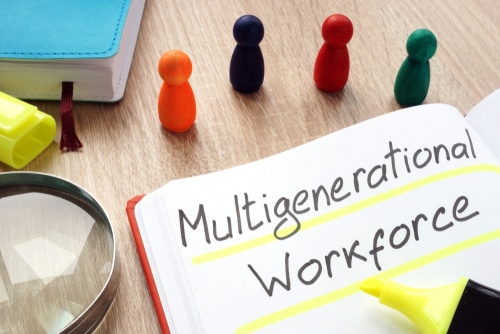From Zoomers to Boomers, today’s workplace comprises four generations with divergent views and perceptions of their employment. What’s on the minds of this increasingly broad employee base as it continues to skew younger and benefit needs become even more nuanced?
ARAG, a leading provider of legal insurance, recently conducted the Multigenerational Workforce Study 2024 to find out. The study collected responses from 2,400 employees across the working generations–Generation Z, Millennials, Generation X and Baby Boomers, and produced some compelling insights to help you get a better understanding of what’s weighing on employees’ minds, the preferred ways they learn about their benefits and how you can promote a higher appreciation of their benefit offerings.
Here are five key findings to keep in mind as you assess your benefit lineup:
1. Employees’ most pressing concerns are financial.
When asked, “What keeps you up at night?,” financial stability was the definitive number one issue for all employees, while worries about ‘future uncertainties’ was a top three concern across all generations. Overall, respondents said they were most concerned about:
- Financial stability (63%)
- Future uncertainties (45%)
- Work-life balance (39%)
- Experiencing high levels of stress or anxiety (37%)
- Their own health issues (35%)
Generation Z led all employees in their concerns for creating work-life balance (51%) and experiencing high stress or anxiety (44%). And perhaps not surprisingly, Boomers were most concerned with their own health issues (37%) and the health issues of someone in their family (29%).
2. Employees are satisfied with their benefits…for the most part.
The study found that the vast majority (76%) of employees feel a level of financial, emotional and mental support from their employer and overall, employees are happy with their benefits. In fact, 69% of employees report being “somewhat to very satisfied” with the benefits program provided by their current employer–and Gen Xers and Boomers are even more satisfied with their benefits than the younger colleagues.
However, of those employees expressing dissatisfaction with their benefits, nearly two-thirds stated the reason was that benefit costs are too high and 42% were dissatisfied because benefit options were limited.
3. For many, voluntary benefits are a mystery.
When it comes to non-medical, voluntary benefits–such as life insurance, financial wellness and planning services, pet insurance or legal insurance, a somewhat surprising 39% of employees say they’re “not at all or only slightly familiar” with these types of benefits. Gen Zers led this category with 41% and conversely, the more experienced Boomers were the most familiar with these benefits.
The study suggests the primary reason for the overall low familiarity with these benefits, as 30% of all respondents indicated, was a lack of communication about them.
4. Employees ask others to help them make benefit decisions.
According to the survey, other people’s opinions do matter when employees are faced with making benefit decisions:
- 40% of employees sought advice from a family member or friend when deciding on employee benefits.
- Gen Z is most likely to seek advice or opinions from their colleagues, friends or family members, with nearly two-thirds tapping into this trusted group of people for help.
- Understandably, Boomers (18%) and Gen X (29%) are far less likely to seek outside advice.
5. Employees’ communication preferences vary.
Many employees across the board (70% of respondents) prefer to receive benefits communication via e-mail; however, there is a noteworthy digital divide among workplace generations when it comes to employees’ communication preferences for receiving information about their benefits.
Younger ‘digital natives’ prefer to have benefits information packaged and delivered electronically. They tend to favor digital booklets, online articles and videos. while older generations prefer printed material. Millennials and Gen Z are also far more amenable to receiving open enrollment information via text.
The study also touched on employees’ perception of AI, as more of these tools are being incorporated into companies’ open enrollment and benefits communication processes. For those who have never used AI-based tools to help review their benefit options, more than half of Gen Z employees were open to that option, while 73% of Boomers said they were unwilling to try.
Surprisingly, even the ‘always online’ generations see a place for traditional direct mail sent home – as it ranked third overall as a preferred way to receive benefit information.
What’s Next?
As you look ahead to open enrollment, the study serves as a good reminder that employees across the board continue to worry about their financial stability and future uncertainties. This opens the door to offer benefits that boost their financial wellness and their overall well-being, like financial counseling, or a student loan repayment plan. Offering a legal insurance plan to prepare for financial and legal challenges can help reduce their anxiety about handling the unexpected.
Employees of various ages have decidedly different levels of understanding of their benefits. Understanding their pressing personal concerns, coupled with their level of satisfaction of how benefits are helping them should help HR leaders make more versatile solutions into their benefit offerings and open enrollment process.
It all presents a timely opportunity for employers to emphasize the real value their benefits deliver, while communicating more–and in a more targeted manner–to strongly support employees’ benefit decision-making and ultimately deliver a better benefits experience.
Jennifer Beck isVP, Customer Experience & Insights at ARAG, a leading legal insurer worldwide. She is responsible for the overall experience of ARAG’s members through the research, analysis, and evaluation of current processes and future trends of both consumer expectations and industry innovations.
The post <strong>Multigenerational Study Reveals Employees’ Distinct Perspectives on Benefits</strong> appeared first on HR Daily Advisor.
